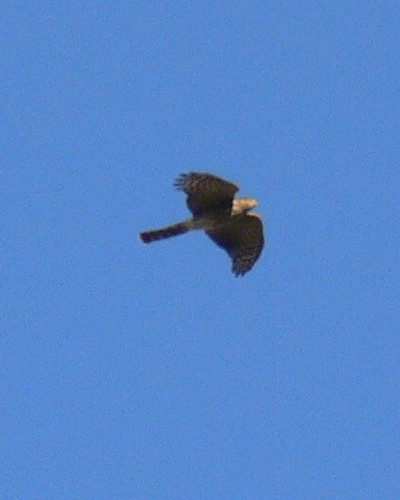I went on a greatly needed jog on Sunday morning, and shortly after I started down Perthshire I heard the eruption of wing claps of about twenty White-winged Doves all taking off at once. They were behind me so I turned around to look. Just after the doves had all left the tree they were in, a Sharp-shinned Hawk flew over it and then over me. After it passed over me I heard an saw another group of doves take flight. Here's a photo of a Sharp-shinned Hawk I took back in October of 2010:
Sharp-shinned Hawks specialize in hunting other birds, so White-winged Doves and other potential prey species are very good at recognizing them fast and taking flight fast. It's amazing what subtle cues the smaller birds can use, and how fast they take flight or make an alarm call. But it's not surprising -- their lives depend on it. And they have to recognize more than Sharp-shinned Hawks. In the winter we have Cooper's Hawks, Merlins, and American Kestrels that will all prey on smaller birds. (A few Cooper's Hawks are here in the summer too.) Year-round we have Northern Shrikes and Eastern Screech-Owls which sometimes prey on birds too.
Being aware of the responses of the smaller birds increases the odds of seeing the predator birds. A group of birds suddenly taking flight is the response I observed on Sunday. Another response is an alarm call which is often a loud high-pitched rattle or chatter. A third response is among flocking birds like starlings and blackbirds. While flying in a flock they will all get closer together when a predator bird gets close. This tightening up of the flock makes it harder for the predator to pick out a single bird.


No comments:
Post a Comment